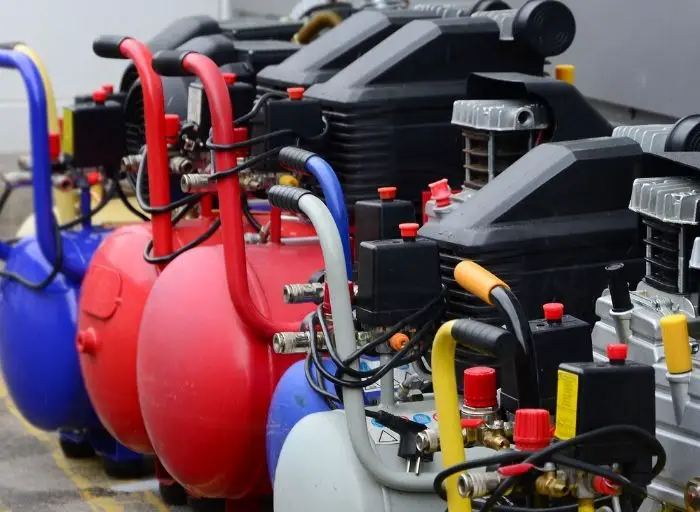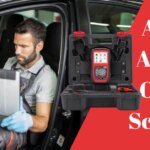
Mobile car detailing businesses are a great way to make decent money on the side or even for your main income stream. But in this work, most people struggle with figuring out air compressor size for mobile auto detailing.
I will share my research and findings on what size air compressor you’ll need to succeed in this business.
Let’s dive into the numbers together and see if you agree.
Mobile car detailing is a great way to make some extra money on the side, even your main business deal. And since there is no or minimal startup cost, it’s a business idea for entrepreneurs on a budget.
This article will look at how to decide what size compressor you need to get started and what kind of results you can expect.
Quick answer:
A small portable air compressor with a tank capacity of 2-3 gallons and air output of 2-3 CFM is sufficient for basic detailing tasks. For intermediate and advanced detailing, a mid-sized or larger stationary air compressor with a tank capacity of 20+ gallons and an air output of 5+ CFM is recommended.
Table of Contents
Types of Air Compressors
Portable air compressors
Portable air compressors are compact and lightweight, making them convenient for mobile auto detailing.
They offer several benefits, such as easy transportation, versatility, and flexibility in different locations. These compressors are suitable for detailers who need to move around frequently and require a portable solution.
However, portable air compressors have limitations, including smaller tank sizes and lower air output compared to larger stationary compressors. It’s important to choose a portable air compressor that balances portability and sufficient performance for auto detailing tasks on the go.
Stationary air compressors
Stationary air compressors are designed for fixed installations in auto detailing shops or garages. They offer advantages such as higher air output, larger tank capacities, and continuous operation for extended periods.
These compressors are suitable for detailers with a dedicated workspace and require a consistent and reliable compressed air source.
However, the main drawback of stationary air compressors is their immobility, making them unsuitable for mobile detailing operations. When selecting a stationary compressor, it’s crucial to consider factors such as required air volume, maximum pressure, and available power supply to meet specific needs.
Oil-lubricated vs. oil-free air compressors
Oil-lubricated and oil-free air compressors differ in terms of their lubrication systems. Oil-lubricated compressors use oil for lubrication, resulting in smoother operation, reduced heat, and longer lifespan. However, they require regular oil changes and proper maintenance.
On the other hand, oil-free compressors do not require oil, making them easier to maintain and eliminating the risk of oil contamination in sensitive applications.
For mobile auto detailing, oil-free compressors are often preferred due to their simplicity, lower maintenance requirements, and reduced risk of oil residue damaging the vehicle’s surface.
However, for specific industrial-grade tasks or heavy-duty applications, oil-lubricated compressors may be more suitable, considering their higher performance and durability. The choice between oil-lubricated and oil-free compressors depends on the specific needs and requirements of the auto detailing operation.
Air Compressor Size for Mobile Auto Detailing – Factors to Consider

Types of air compressors
There are two types of air compressors: portable and stationary. They both work similarly: compressed air is used to blow air through a hose connected to the nozzle.
The difference lies in where they are used. A portable air compressor is usually carried around by the user, which allows them to be used at different locations. On the other hand, a stationary air compressor is usually placed at a single location, such as an auto shop or a detailer’s shop.
With that said, let’s look at how much power you need for your business.
How much power do you need
If you think about how much power a person needs to perform a specific task (and, in turn, how much effort he or she will expend), then you can come up with a reasonable estimate of how much power you need to perform a particular task. So, if you want to be able to start your own business, the answer is likely going to be that you don’t need as much power as you’d think. And if you’re working in a large company, the amount of power you need to accomplish anything maybe even less than you think.
How much storage do you have
When it comes to air compressors, a lot depends on the size and storage capacity of the air compressor you decide to use. In addition, if you are using a mobile air compressor, you’ll also have to look at how much storage you’ll have when you are traveling around with the air compressor.
This is important because if you’re looking at air compressors for mobile detailing, you’ll want to consider that you’ll need a compressor that you can fit in the trunk or backseat of your car.
How much air compressor do I need?
It’s a common question among people who are just getting started in the mobile business.
And the answer is: “It depends.” On what? The size of your operation, the type of work you are going to be doing, and several other factors. But there is one factor, in particular, that is the most important of all, and it is the one factor that you, as the operator of the business, have the most control over.
So if you’re going to use the air compressor for some heavy work like waxing and polishing, you’ll need a lot of power. But if you plan to do light-duty work, such as cleaning and vacuuming, you can expect much less power from your compressor.
What Size Compressor Should I Buy – How Big Should My Air Compressor Be
When it comes to mobile auto detailing setups, the size of the air compressor plays a significant role in meeting the air supply requirements for various tasks. Here are some recommendations based on different mobile auto detailing setups:
Basic detailing
For a compact setup that focuses on basic detailing tasks such as interior cleaning, vacuuming, and light exterior work, a small portable air compressor with a tank capacity of around 2-3 gallons and a minimum air output of 2-3 CFM (cubic feet per minute) should suffice. This size is suitable for inflating tires, operating small air tools like blow guns or airbrushes, and powering pneumatic vacuum cleaners.
Intermediate detailing
A mid-sized portable or stationary air compressor is recommended for an intermediate setup that includes a wider range of tasks such as paint correction, polishing, and using pneumatic tools like orbital polishers or air sanders. Aim for a tank capacity of 20-30 gallons and an air output of 5-7 CFM or higher. This size provides sufficient air supply for longer operations without frequent refills and offers more power for operating various air tools.
Advanced detailing
For a comprehensive setup that involves heavy-duty tasks like sandblasting, running multiple air tools simultaneously, or operating larger pneumatic equipment, a larger stationary air compressor is necessary. Consider a compressor with a tank capacity of 60 gallons or more and an air output of 10 CFM or higher. This size ensures a continuous and abundant air supply for demanding applications, allowing you to tackle advanced detailing tasks effectively.
You can find these air compressors in a rental car and trailer shops, construction supply stores, tool and equipment rental places, and even discount retailers like Harbor Freight Tools and Home Depot.
As a general rule, if your business is going to involve waxing, polishing, or heavy use in general, you’ll need a compressor with many horsepowers. On the other hand, if your business is mostly vacuuming and light-duty work, you can get by with a much smaller air compressor.
Common Mistakes when Selecting an Air Compressor for Mobile Auto Detailing
When selecting an air compressor size for mobile auto detailing, it’s important to avoid common mistakes leading to inefficient operation or inadequate air supply. Here are some mistakes to avoid:
Underestimating air requirements
One common mistake is underestimating the air requirements of your mobile auto detailing tasks. Make sure to assess the specific air tools and equipment you will be using and determine their CFM (cubic feet per minute) or PSI (pounds per square inch) requirements. Select an air compressor size that can meet or exceed these requirements to ensure optimal performance.
Ignoring duty cycle
The duty cycle refers to how long an air compressor can operate continuously within a given time frame. Ignoring the duty cycle can result in overheating and premature wear of the compressor. Consider the duty cycle rating of the air compressor and ensure it aligns with the demands of your detailing tasks. Higher duty cycle ratings are preferable for longer operating times.
Overemphasizing tank size
While tank size is important for storing compressed air, it does not directly determine the continuous operation time or the air tool’s performance. Avoid solely focusing on tank size without considering the compressor’s CFM output. A larger tank may hold more air, but if the CFM output is insufficient, the compressed air will deplete quickly, leading to inadequate performance.
Disregarding power source compatibility
Air compressors require a suitable power source, such as electricity or gasoline. Ensure that the compressor you choose is compatible with the power source available in your mobile detailing setup. Neglecting power source compatibility can lead to operational issues and limit the mobility of your compressor.
Overlooking portability and mobility
Mobile detailing setups require portable equipment. Consider the weight, size, and mobility features of the air compressor. Ensure it is manageable to transport and maneuver in different locations. Heavy or bulky compressors can hinder mobility and complicate the detailing process.
Neglecting noise considerations
Noise levels can impact your work environment and may have regulatory restrictions. Neglecting noise considerations can result in disturbances for yourself, your clients, or the surrounding area. Look for air compressors specifically designed with noise reduction features or choose models with lower decibel ratings to minimize noise emissions.
How To Maintain and Care for Air Compressors
Proper maintenance and care are crucial for air compressors’ longevity and optimal performance. Here are some important steps to maintain and care for your air compressor:
- Regular inspection: Conduct routine inspections to check for any signs of wear, leaks, or damage. Inspect the hoses, connections, belts, filters, and valves to ensure they are in good condition.
- Lubrication: Follow the manufacturer’s guidelines for lubrication. Some compressors require regular oil changes, while others may be oil-free. Lubricate the necessary components as recommended to prevent friction and ensure smooth operation.
- Filter maintenance: Clean or replace air filters regularly to prevent dirt and debris from entering the compressor. Clogged filters can hinder airflow and decrease performance. Refer to the manufacturer’s instructions for filter maintenance intervals.
- Drain moisture: Air compressors generate moisture during operation. Drain any accumulated moisture from the tank regularly to prevent corrosion and maintain air quality. Check the drain valve and ensure it is functioning correctly.
- Check and adjust belt tension: Inspect the belts for proper tension if your compressor has a belt-driven system. Adjust them as necessary to ensure efficient power transmission. Loose or worn-out belts can lead to reduced performance or slippage.
- Keep clean and dust-free: Regularly clean the exterior of the compressor to prevent dust and debris from entering the internal components. Use a damp cloth or compressed air to remove dirt and ensure proper ventilation.
- Maintain proper air pressure: A pressure gauge monitors and maintains the appropriate air pressure. Excessive pressure can strain the compressor, while insufficient pressure may affect performance. Adjust the pressure settings according to your specific needs.
- Follow operating guidelines: Adhere to the manufacturer’s operating instructions and safety guidelines. Properly start, operate, and shut down the compressor to prevent damage and ensure operator safety.
Check out This Video for How to Detail a Car without Air Compressor!
Frequently Asked Questions
What size air compressor is the best for mobile auto detailing?
It depends on the work you’re mainly doing regularly. Suppose you will be waxing, polishing, or doing heavy-duty cleaning with the air compressor. In that case, you’ll want to get a bigger air compressor than if you are going to use it mostly for light-duty cleaning and vacuuming.
Is 10 gallons enough?
If you plan to use your air compressor for waxing and polishing, you’ll need a big air compressor. But if you are going to use it for light-duty cleaning, you’ll probably only need about 10 gallons of air.
How many CFM compressors do I need for auto detailing?
No matter what compressor you buy, ensure it has at least 3 CFM. You will need this minimum amount of power to get the job done. If your compressor has less than 3 CFM, you won’t have enough power to do a thorough job.
How many PSI do I need for automotive detailing?
In addition to the CFM, you should also consider how much pressure you will need to work with. This is because many air compressors work better at higher pressure.
For example, if you use your compressor to clean an entire car, you’ll need to work at a higher pressure to suck up all the debris and dirt. But if you are doing light-duty work, such as vacuuming and light-duty cleaning, you can get away with working at lower pressure.
Can 3-gallon air compressor run an impact wrench? or an electric drill?
Absolutely! And in fact, it can run multiple tools at once. If you want to do any serious work, you’ll definitely want to get a bigger air compressor. And if you want to run more than one tool at a time, you’ll probably need a larger air compressor.
Why are air compressors so loud?
Air compressors can be loud due to factors such as mechanical components generating vibrations and friction, turbulent airflow during air intake and discharge, high-speed operation, and the absence of soundproofing measures. However, technological advancements have developed quieter air compressors with improved insulation, sound-dampening materials, and better component design.
Can I use multiple air compressors together to meet my air tool requirements?
Of course, you can. This approach, known as parallel compressor operation, allows you to combine the air output of multiple compressors to achieve higher airflow or pressure levels.
Hi everyone, My name is Ollie Barker.
As a seasoned auto expert I have 25 years of experience working in repair and detailing shops. I love to share my tips & tricks to all car lovers, so that’s why I’m here at Automotive Gearz publishing my content, sharing my passion. Also, I’ve been giving my recommendations on which products are the best to have on the market. I always thought it was hard to pick the right part, so hopefully I can make that a bit easier for you.
Hope you enjoy your time on my little blog!







